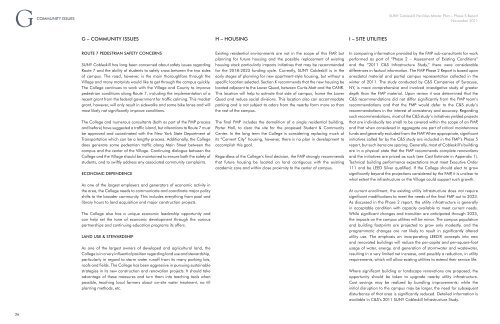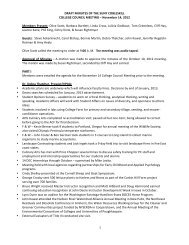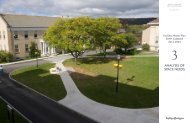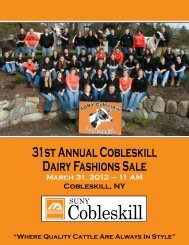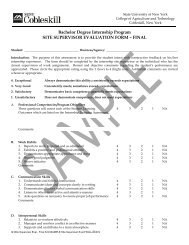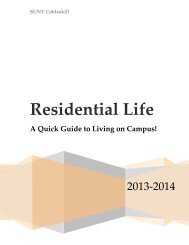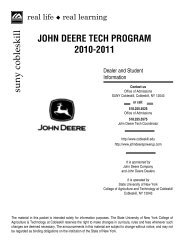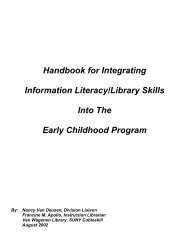Part 5: Final Recommendation - SUNY Cobleskill
Part 5: Final Recommendation - SUNY Cobleskill
Part 5: Final Recommendation - SUNY Cobleskill
Create successful ePaper yourself
Turn your PDF publications into a flip-book with our unique Google optimized e-Paper software.
GCOMMUNITY ISSUES<br />
<strong>SUNY</strong> <strong>Cobleskill</strong> Facilities Master Plan – Phase 5 Report<br />
November 2011<br />
G – COMMUNITY ISSUES<br />
H – HOUSING<br />
I – SITE UTILITIES<br />
ROUTE 7 PEDESTRIAN SAFETY CONCERNS<br />
<strong>SUNY</strong> <strong>Cobleskill</strong> has long been concerned about safety issues regarding<br />
Route 7 and the ability of students to safely cross between the two sides<br />
of campus. The road, however, is the main thoroughfare through the<br />
Village and many motorists would like to get through the campus quickly.<br />
The College continues to work with the Village and County to improve<br />
pedestrian conditions along Route 7, including the implementation of a<br />
recent grant from the federal government for traffic calming. This modest<br />
grant, however, will only result in sidewalks and some bike lanes and will<br />
most likely not significantly improve conditions.<br />
The College and numerous consultants (both as part of the FMP process<br />
and before) have suggested a traffic island, but alterations to Route 7 must<br />
be approved and coordinated with the New York State Department of<br />
Transportation which can be a lengthy process. Additionally, the College<br />
does generate some pedestrian traffic along Main Street between the<br />
campus and the center of the Village. Continuing dialogue between the<br />
College and the Village should be maintained to ensure both the safety of<br />
students, and to swiftly address any associated community complaints.<br />
ECONOMIC DEPENDENCE<br />
As one of the largest employers and generators of economic activity in<br />
the area, the College needs to communicate and coordinate major policy<br />
shifts to the broader community. This includes everything from pool and<br />
library hours to land acquisition and major construction projects.<br />
The College also has a unique economic leadership opportunity and<br />
can help set the tone of economic development through the various<br />
partnerships and continuing education programs its offers.<br />
LAND USE & STEWARDSHIP<br />
As one of the largest owners of developed and agricultural land, the<br />
College is in a very influential position regarding land use and stewardship,<br />
particularly in regard to storm water runoff from its many parking lots,<br />
roofs and fields. The College has been aggressive in pursuing sustainable<br />
strategies in its new construction and renovation projects. It should take<br />
advantage of these measures and turn them into teaching tools when<br />
possible, teaching local farmers about on-site water treatment, no till<br />
planting methods, etc.<br />
Existing residential environments are not in the scope of this FMP, but<br />
planning for future housing and the possible replacement of existing<br />
housing stock particularly impacts initiatives that may be recommended<br />
for the 2018-2023 funding cycle. Currently, <strong>SUNY</strong> <strong>Cobleskill</strong> is in the<br />
early stages of planning for new apartment-style housing, but without a<br />
specific location selected. Section K recommends that the new housing be<br />
located adjacent to the Lower Quad, between Curtis Mott and the CANR.<br />
This location will help to activate that side of campus, frame the Lower<br />
Quad and reduce social divisions. This location also can accommodate<br />
parking and is not subject to odors from the nearby farm more so than<br />
the rest of the campus.<br />
The final FMP includes the demolition of a single residential building,<br />
Porter Hall, to clear the site for the proposed Student & Community<br />
Center. In the long term the College is considering replacing much of<br />
its “Cement City” housing, however, there is no plan in development to<br />
accomplish this goal.<br />
Regardless of the College’s final decision, the FMP strongly recommends<br />
that future housing be located on land contiguous with the existing<br />
academic core and within close proximity to the center of campus.<br />
In comparing information provided by the FMP sub-consultants for work<br />
performed as part of “Phase 2 – Assessment of Existing Conditions”<br />
and the “2011 C&S Infrastructure Study,” there were considerable<br />
differences in factual information. The FMP Phase 2 Report is based upon<br />
anecdotal material and partial campus representation collected in the<br />
winter of 2011. The study conducted by C&S Companies of Syracuse,<br />
NY, is more comprehensive and involved investigative study of greater<br />
depth than the FMP material. Upon review it was determined that the<br />
C&S recommendations did not differ significantly from the FMP team’s<br />
recommendations and that the FMP would defer to the C&S study’s<br />
recommendations in the interest of consistency and accuracy. Regarding<br />
such recommendations, most of the C&S study’s initiatives yielded projects<br />
that are individually too small to be covered within the scope of an FMP,<br />
and that when considered in aggregate are part of critical maintenance<br />
funds and generally excluded from the FMP. When appropriate, significant<br />
initiatives called for by the C&S study are included in the FMP’s Phase 5<br />
report, but such items are sparing. Generally, most of <strong>Cobleskill</strong>’s building<br />
are in a physical state that the FMP recommends complete renovations<br />
and the initiatives are priced as such (see Cost Estimate in Appendix 1).<br />
Technical building performance expectations must meet Executive Order<br />
111 and be LEED Silver qualified. If the College should elect to grow<br />
significantly beyond the projections considered by the FMP, it is unclear to<br />
what extent the infrastructure or the Village could support such growth.<br />
At current enrollment, the existing utility infrastructure does not require<br />
significant modifications to meet the needs of the final FMP out to 2023.<br />
As discussed in the Phase 2 report, the utility infrastructure is generally<br />
in acceptable condition with capacity available to meet current needs.<br />
While significant changes and transition are anticipated through 2023,<br />
the impacts on the campus utilities will be minor. The campus population<br />
and building footprints are projected to grow only modestly, and the<br />
programmatic changes are not likely to result in significantly altered<br />
utility use. The emphasis on incorporating LEED® concepts into new<br />
and renovated buildings will reduce the per-capita and per-square-foot<br />
usage of water, energy, and generation of stormwater and wastewater,<br />
resulting in a very limited net increase, and possibly a reduction, in utility<br />
requirements, which will allow existing utilities to extend their service life.<br />
Where significant building or landscape renovations are proposed, the<br />
opportunity should be taken to upgrade nearby utility infrastructure.<br />
Cost savings may be realized by bundling improvements; while the<br />
initial disruption to the campus may be larger, the need for subsequent<br />
disturbance of that area is significantly reduced. Detailed information is<br />
available in C&S’s 2011 <strong>SUNY</strong> <strong>Cobleskill</strong> Infrastructure Study.<br />
26


